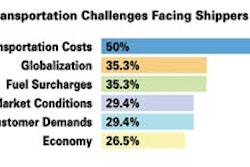By Mark Sutcliffe
In most North American consumer packaged goods (CPG) plants, the knowledge, skills and experience of the shop floor workers are being severely underused.
Most operations executives fundamentally recognize this. But the high variability and unique challenges of process manufacturing have prevented them from fully harnessing their human capital. As a result, the workforce is the largest unmonitored and unmanaged constraint in CPG factories today.
Over the last two years, a number of CPG organizations have taken a different approach. And by tackling the problem from a different angle, they are leveraging their hourly workforce to achieve double-digit efficiency gains and break the chains of competition.
Wrong Group, Wrong Approach, Wrong Problem
Since the mid-1990s, CPG companies have spent an enormous amount of time and energy on reducing equipment-based constraints. They have focused on changing the equipment's configuration, improving flow, changing the way equipment is set up or changing the layout of the facility.
The assumption was — and for many still is — that this efficiency challenge is a physical one. So, these projects have traditionally been assigned to the group in charge of the physical infrastructure: engineering.
Under engineering's guidance, thousands of CPG manufacturers have invested millions in initiatives such as manufacturing execution systems (MES) implementations. Yet after years of working on physical constraints and deploying MES, most companies have little to show in terms of improved productivity.
MES, for all its fanfare, has largely failed to deliver on its promise. And many executives are now realizing that they have been assigning the wrong group and using the wrong solutions to solve the wrong problem.
A Practical People-centric Approach
The efficiency problem in today's CPG factories is not an engineering problem. It's not a physical equipment problem. It's a people problem. It's a workflow and management problem — one that must be tackled within operations, not engineering.
The key to solving this elusive challenge lies in providing the shop floor with a system it can actually use, a system that enables it to improve its own performance in real time. Specifically, the key is people-centric applications that allow the workers to contribute their knowledge and experience, not a data-hungry beast that only leads to more work and cynicism on the factory floor.
Systemizing the Human Contribution
For a growing number of companies, manufacturing operations management (MOM) systems have been the answer. These practical, people-centric applications are specifically designed to improve the performance of the workers on the production line by allowing them to improve their own performance in real time.
By systemizing the human element, MOM systems take what has traditionally been a theoretical, feel-good concept (the idea that people are the key) and makes production efficiency improvements practical, repeatable and predictable.
Hundreds of CPG companies — from makers of salads, yogurt, entrees, sauces, cakes and cheese products — have already deployed MOM applications, and many have experienced immediate efficiency gains of 20 percent or greater without an increase in labor hours.
Not surprisingly, leading analysts are taking notice. In fact, both Gartner and Forrester have recently published research briefs touting the benefits of this unique category.
For CPG companies caught in the downward spiral of fierce competition and rising production costs, trying to improve business performance with another engineering-led initiative is not the answer. The solution lies is using a people-centric approach that systemizes and "packages" the human contribution, making results predictable and sustainable.
 | About the Author: Mark Sutcliffe is the general manager for CDC Factory at CDC Software, an enterprise software company. For more information, visit www.cdcsoftware.com. |



















